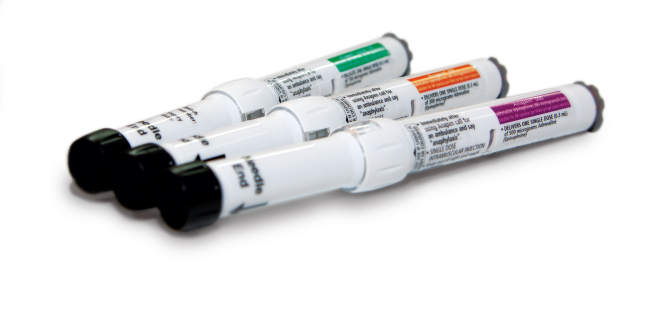What does anaphylaxis mean?
Anaphylaxis is the medical term for a sudden, severe allergic reaction which can be potentially life-threatening. It should always be treated as a medical emergency, requiring immediate treatment.
Not all people with allergies will develop anaphylaxis.
How anaphylaxis occurs
For those with severe allergies, exposure to their particular allergen causes their immune system to go into overdrive and release a flood of chemicals that can lead to an anaphylactic reaction including a sudden drop in blood pressure, and a narrowing of the airways which leads to difficulty in breathing.
During anaphylaxis, the immune system overreacts and develops antibodies to substances that are normally harmless, such as some foods, for example, peanuts, tree nuts, milk, eggs, fish, shellfish, soy and wheat, pollens, drugs (over the counter and alternative therapies), latex, insect bites, and even exercise.
When the allergic substance or ‘trigger’ is encountered again, the allergic antibodies lead to a massive release of histamine and other substances which can cause a severe allergic reaction in the body.
What does anaphylaxis look like?
Anaphylaxis symptoms, may include any one of the following:
- Breathing difficulties, such as fast, shallow or noisy breathing
- Wheezing or persistent cough
- Swelling of the tongue
- Swelling or tightness in the throat
- Confusion and anxiety
- Difficulty talking or hoarse voice
- A rapid, weak pulse
- Skin rash
- Clammy skin
- Feeling lightheaded, dizzy or faint
- Collapsing or loss of consciousness
- Pale and floppy (in young children)
Sometimes there are early signs and symptoms of a mild to moderate reaction which may develop into anaphylaxis. These include:
- Swelling of the face, eyes and/or lips
- Abdominal pain and vomiting which are signs of anaphylaxis for an insect allergy
- Hives or welts
A severe allergic reaction or anaphylaxis usually occurs within 20 minutes to two hours of exposure to the trigger and can rapidly become life threatening. It is important to remember your reaction may vary from one exposure to the next and symptoms may not always appear straight away.

How is anaphylaxis treated?
There are two pathways to treatment. The first is to identify the cause of anaphylaxis and your particular allergy ‘trigger’, so you can avoid it.
In the case of a severe allergic reaction, the second pathway is first aid treatment with the immediate injection of adrenaline (epinephrine) into the outer mid-thigh muscle using an adrenaline auto-injector such as Anapen®, followed by close medical supervision in a hospital.
Call 000 in Australia for emergency assistance and tell them you (or the patient) has anaphylaxis, even if you think they are getting better.
Lie the patient down flat and don’t let them stand up or walk around. If they are unconscious or pregnant, put them in the recovery position lying on their left side. If they are struggling to breathe, allow them to sit with their legs stretched out straight. If a young child is unconscious, hold them flat, not upright.
Call their family or emergency contact and if after five minutes, there is no response to the initial shot of adrenaline, give them another dose. The second dose of adrenaline is usually given in the other thigh.
If you know the patient has asthma and you are unsure if it is an asthma attack or anaphylaxis, always give the adrenaline first, followed by the asthma puffer.
Commence CPR at any time if the person is unresponsive and not breathing normally.
Once in hospital, the patient requires at least four hours of observation.
Why adrenaline for anaphylaxis
Adrenaline is a natural hormone released in response to stress. It makes your heart beat faster and your lungs breathe more efficiently. When injected, it rapidly reverses the effects of anaphylaxis by sending more blood to the brain and muscles, increasing your blood pressure, making you more alert, and raising sugar levels in the blood to give you energy.
Be prepared BEFORE an emergency:
If you or a loved one have severe allergies that may lead to anaphylaxis, ensure you know how to use your Anapen® adrenaline auto-injector in case of emergency.
Familiarise yourself with how the device works and practice the steps to use regularly so there is no hesitation in how to use it when needed. It is good to practice with an Anapen® training device or via the online 3D Anapen® animation.

How long does anaphylaxis last?
Anaphylaxis develops rapidly, usually reaching peak severity within five to 30 minutes, and may last for several days, although this is rare.
The best management is to avoid contact with known allergens and to carry your Anapen® and ASCIA Action Plan at all times.


ASCIA Action Plan
When your healthcare professional prescribed Anapen®, you will also have received your ASCIA Action Plan for Anaphylaxis.
You should always carry your ASCIA Action Plan with you, along with your Anapen®. Your ASCIA Action Plan includes key information relating to your allergy/allergies, as well as emergency protocols, what to look out for and what to do.
It is a good idea to ensure family, friends, teachers, childcare staff and work colleagues are also familiar with your Action Plan and know how to use the Anapen® auto-injector in case of emergency.
For more information, visit Australasian Society of Clinical Immunology and Allergy (ASCIA) and Allergy & Anaphylaxis Australia (A&AA)
